Gazing out the open cargo doors of the Huey flying over Phouc Long Province, boyish-looking Specialist 4 Robert Pryor took in an endless landscape of mountains, meandering rivers and rolling hills covered with dense evergreen vegetation, bamboo thickets, and triple canopy tropical broadleaf forests. The forbidding wilderness had an odd virginal beauty. It was also one of the most dangerous places in South Vietnam.
This sparsely populated highland plateau, nestled along the Cambodian border some 65 miles northeast of Saigon, had long been a North Vietnamese Army and Viet Cong stronghold. Its isolation offered them a safe hideaway where food and equipment could be replenished while units rested, trained, or prepared for future operations in the III Corps Tactical Zone.
Fiercely contested by government and Communist forces, several deadly battles had been fought over the region. One bloody battle took place 24 kilometers from Pryor’s destination, Camp Bunard, in June 1965, when the Special Forces camp at Dong Xoai was overrun, leaving seven Americans dead and three missing.
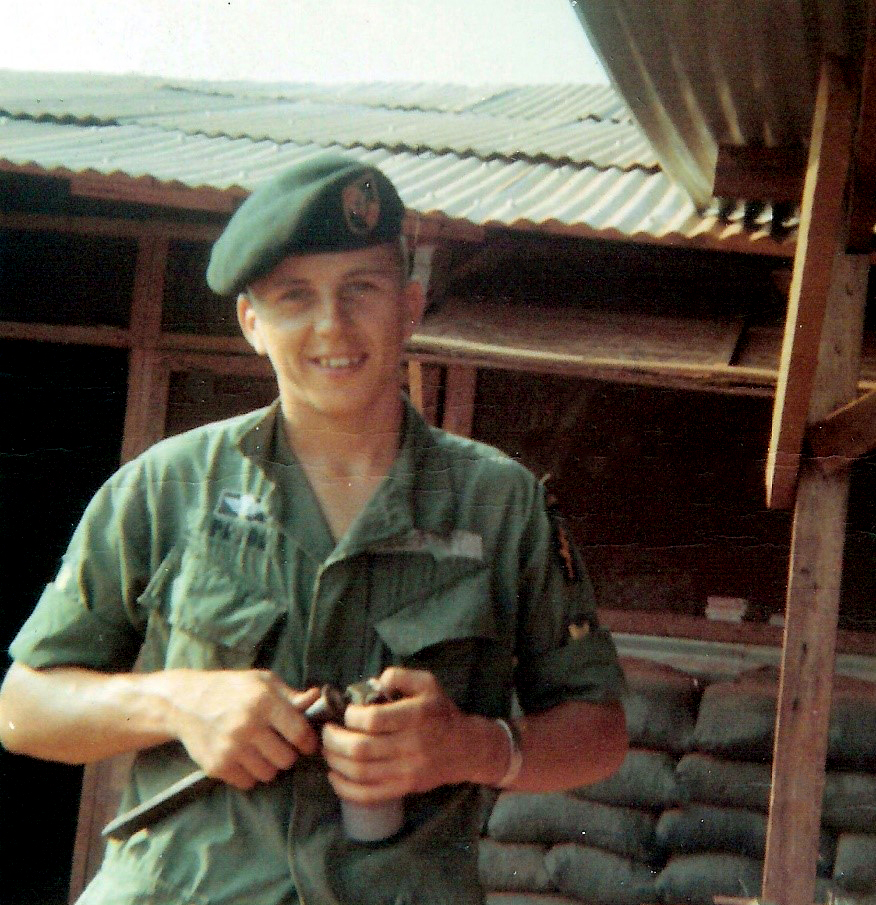
Arrival at Camp Bunard and the Battle of Camp Bunard
On this late January day in 1969, Pryor’s first glimpse of Camp Bunard came from about five kilometers out. It appeared smaller than he expected. A kilometer northwest of the camp was the New Life Hamlet of Dia Diem Bunard. Here, Cambodians, Vietnamese and Montagnards lived in a village created as part of the pacification program devised by South Vietnam and its U.S. advisers.
Pryor was met by several of his new teammates of Detachment A-344 and shown around. An A-team, the Special Forces‘ smallest unit, ordinarily consisted of about 12 men at the time, although A-344 was undermanned. Ideally, a unit had two Medics, two commo Sergeants, a team operations Sergeant, an intelligence Sergeant, two combat engineers, a detachment commanding officer, a detachment Executive Officer, a light weapons Sergeant, a heavy weapons Sergeant and sometimes an attached Civil Affairs/Psychological Operations Officer. In Vietnam, few camps were ever full strength. On the ground, the camp felt even smaller than it looked from the air. As one of Bunard’s combat engineers, Pryor would be responsible for keeping the buildings and defenses in good repair. Smaller meant his job would be more manageable.

Training and Early Combat Before the Battle of Camp Bunard
When Pryor had arrived at 5th Special Forces Group Headquarters in Nha Trang shortly before Christmas 1968, he was 19 years old and had been in the Army nearly two years, mostly in the United States: basic, advance, airborne, Special Forces and Vietnamese language. Perhaps because Pryor looked more like 14 to some, it was decided that he could use some more training. After four weeks of Recondo School, Pryor was assigned to Bunard.

In his first six months there, he had seen his share of firefights, boldly faced down the enemy, received his first Purple Heart after being wounded by shrapnel fragments, and turned 20. Now, with the approach of summer, he was experiencing his first rainy season.
The Perfect Storm at Camp Bunard
Typically, monsoon rains are sudden and short. But the heavy storm hitting Camp Bunard on Wednesday, June 17, 1969, had been pounding the camp for hours with no sign of letting up.
At 5:30 a.m. on the 18th, Pryor had just finished radio watch. He stood at a doorway of the windowless, concrete bunker that housed the team’s tactical operations center (TOC), eyeing the huge puddle and muddy clay between him and his breakfast in the team house.
“What the hell,” he mumbled as he pulled up his collar and bolted into the driving rain through the mud field. There in seconds, he yanked open the screen door and scrambled inside.

The only people there were the camp’s two Cambodian cooks, who started whipping up Pryor’s breakfast as soon as he walked in. He quickly devoured his eggs, canned bacon, toast, and coffee, and reached into his breast pocket for a plastic bag that held a half-empty pack of Benson & Hedges cigarettes and his Zippo. He lit up, leaned back in his chair, and drew the smoke deep into his lungs. As he stared out the screen window, the rain suddenly stopped.
Pryor went out to check around the camp to see if there had been any damage from the rain that would need repair. Finding only a lot of soggy sandbags, he headed to his hooch to grab some sleep.
Americans Left Vulnerable Before the Battle of Camp Bunard
He was in a deep sleep when he was awakened around 8:30 a.m. by a clamor in the hall outside his room. He figured it was Sgt. 1st Class Daniel Dudley, a Weapons Sergeant, and Staff Sgt. Charles Orona, Senior Medic, heading out on the patrol they had been assigned the night before by the detachment commander, 1st Lt. John Parda. The patrol’s mission was to look for any signs of Viet Cong east of the camp. In addition to Dudley and Orona, the three-day patrol would include two Vietnamese Special Forces operators and 60 members of the Civilian Irregular Defense Group (CIDG).
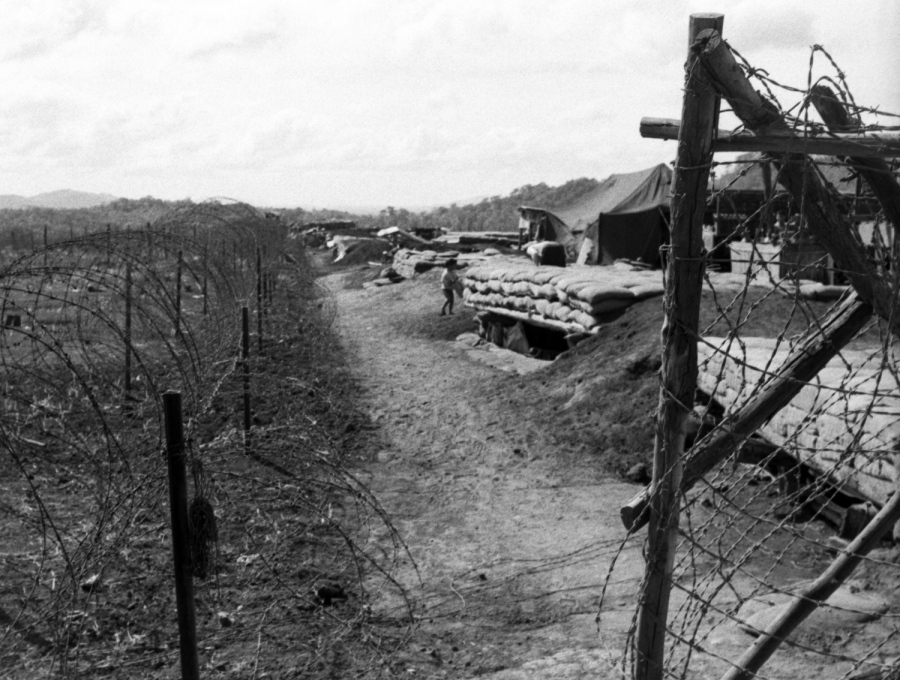
Hoping to fall back asleep, Pryor rolled over. He shut his eyes for a second or two when they suddenly snapped back open as a startling thought ran through his mind: There are not enough Americans left in the camp!
Just a couple days earlier, Master Sgt. John Nowlan and Sergeant Larry Crile, the team’s junior medic, left for R&R in Australia. Now, with Dudley and Orona out on patrol, that left only four Americans to defend the camp, along with a handful of Vietnamese Special Forces and around 50 CIDG personnel who, more than likely, included some Viet Cong infiltrators.
Along with Pryor, the three remaining Americans at Bunard were 1st Lt. Parda, Sgt. 1st Class Carl Cramer, commo Sergeant, and Sgt. 1st Class Charles Hinson, Senior Intelligence Sergeant.
Preparations for the Battle of Camp Bunard
As he mulled over the seriousness of the situation, Pryor decided maybe it wasn’t all that dire. They had three things going for them.
First, all the Americans were seasoned warriors. Second, there had been only a few enemy contacts in the past few months. And third, security conditions were better than they had ever been since his arrival in January because two rifle companies with more than 200 men from the 1st Infantry Division were operating out of a mini firebase directly beyond Bunard’s outer perimeter for nearly a month. Their patrolling provided enormous security to Bunard. Added to that, the division’s massive firepower available to support the camp anytime it was needed. Matter of fact, Big Red One units were laced across the region as security for crews clearing away heavy vegetation along both sides of Highway 14.
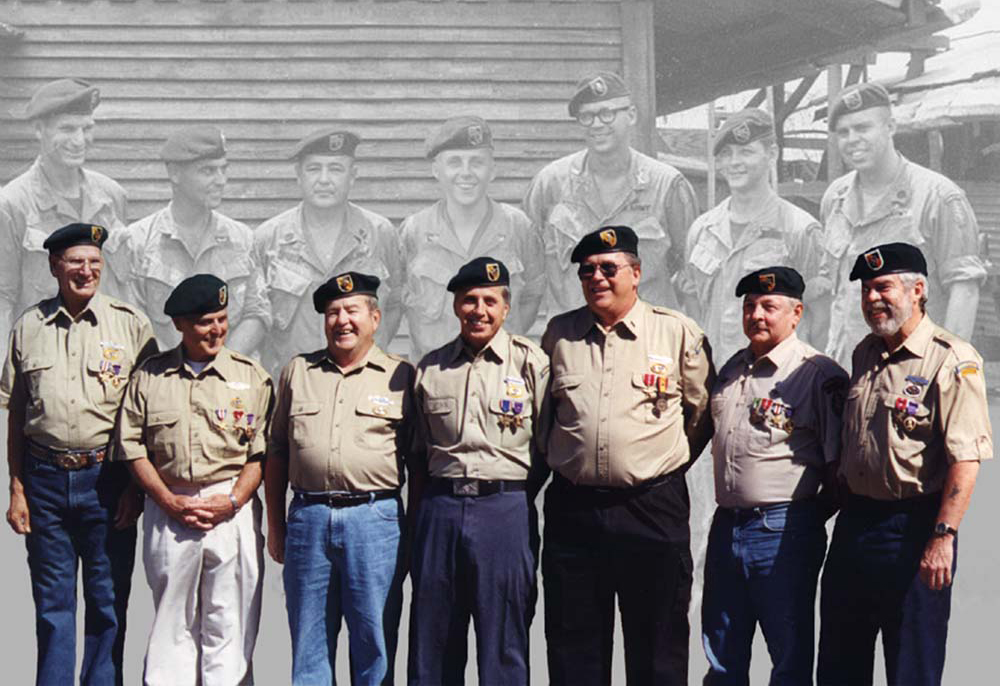
So, with enemy activity near zero, plus the 1st Infantry Division carrying out much of the security mission, Pryor decided it wasn’t as grim as he had first imagined and drifted back to sleep.
Along with the others in the camp, Pryor spent the rest of the day carrying out routine activities. While leading a crew doing minor fixes on the camp’s defenses, he saw no signs of impending danger. That night, he did his routine radio watch, finally going to bed at 3 a.m., knowing all was well.
Security Breach Before the Battle of Camp Bunard
When Pryor awoke at dawn on the 19th, however, he and the other three Americans were shocked to learn that the 1st Infantry Division element next door had moved out during the night. Not one of the four Americans at Bunard had been told about the planned move.
Literally overnight, having too few Americans at Camp Bunard suddenly became a problem of major consequences.
There was yet another condition unfolding at that moment that no one could have imagined. More than 100 well-armed Viet Cong were making their way through the jungle toward the camp.
A “perfect storm” of singular fury was blowing directly at Camp Bunard.
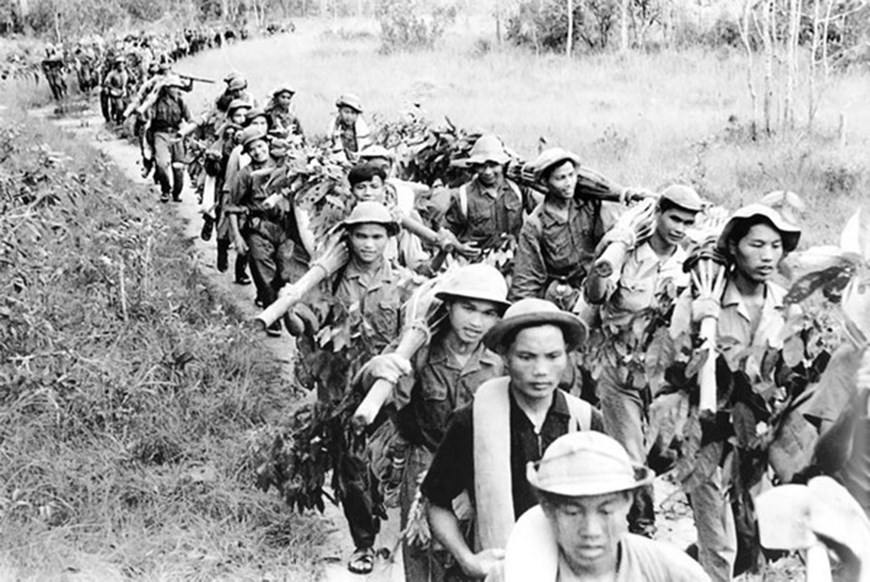
Mortars and Firestorm at Camp Bunard
Among the Americans in the camp, there was now a heightened sense of alertness. The rest of the day, everyone had a more critical eye on security conditions and making adjustments where needed. Late in the afternoon, Pryor and Parda went over to the abandoned 1st Infantry Division firebase to scrounge around for anything that could be used to reinforce Bunard’s defenses. They found barbed wire, heavy lumber, and other construction items, but because it was getting dark, they decided to return the next morning with a work party and haul it back to the camp.
Scheduled for radio watch that night from 11:30 to 1 a.m., Pryor decided to read a book he had just started rather than try to sleep. Around 11 p.m., he shoved the paperback into his side pocket, put on his web gear, secured his M-16, and headed out of the hooch.
It was his normal routine to walk the camp perimeter, looking for anything out of the ordinary before reporting to the TOC. This night was pitch black. Even the waxing moon was invisible behind the low hanging clouds. All he could see were shadows and darkness, but as best he could determine, nothing was amiss.
Pryor relieved Carl Cramer, who reported everything was quiet. The A-team patrol had reported no signs of enemy activity since they started out the day before. No messages had been received from B-Detachment headquarters at Song Be, 22 kilometers northwest of Bunard. No news was good news, especially since the camp’s manpower shortage and the loss of its 1st Infantry Division “security blanket.”
Yawning, Cramer picked up his M-16 and the letter he had written to his wife, bid Pryor “good night,” and shuffled off to bed. After making sure all radios were operational, Pryor, a three-pack-a-day smoker, sat down and lit up a cigarette. He spent his two-hour radio watch finishing his paperback. Just before 1 a.m. on June 20, Charles Hinson entered the TOC ready for his radio watch. Pryor reported what Cramer had passed on to him: All was quiet. He then left for bed.
Inside his room, Pryor sat on the edge of his bunk, picked up a crumpled pack of cigarettes and his Zippo from the table, lit a cigarette, and drew the smoke in. The smoke irritated his throat, and as he coughed, he admonished himself, “Someday I’ve got to quit smoking.” He reached down to unzip his jungle boots, slipped off his trousers, and tossed them in a heap at the side of the bed.
Leaning back on the bed, Pryor took another drag, and again he hacked and thought to himself: “Who am I kidding? There is no way in hell I will ever quit smoking.” He started to take another drag, but as he did, all hell broke loose-the world of Camp Bunard and Robert Pryor was about to be torn to pieces from a firestorm of mortars, rocket-propelled grenades, and heavy machine gun and small-arms fire was raining down on the camp. Along the Bunard’s outer perimeter, a swarm of Viet Cong sappers and soldiers were about to breach the wire.
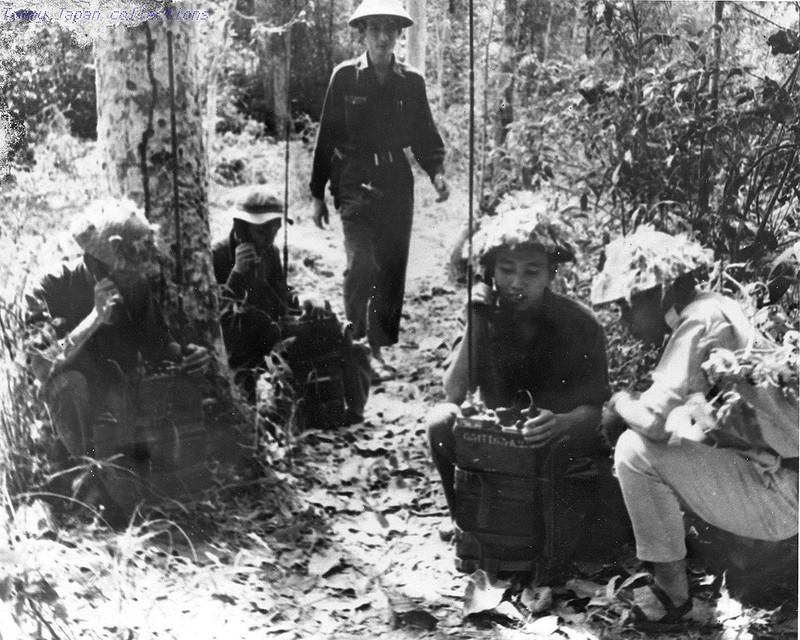
Pryor butted his cigarette, pulled on his trousers and boots, grabbed his M-16, a radio and his ammunition belt, and bolted out the door toward his assigned mortar pit about 10 meters away. Instantly, he was met with enemy fire pouring from the outer perimeter but made it unscathed to the mortar pit, grabbed a ready-to-fire illumination round, and dropped it down the 81mm tube. He dropped a couple more illumination rounds into the tube as fast as he could. The three rounds exploded brightly in the dark sky, casting eerie shadows throughout the camp. Two such shadows rushed to the mortar pit, startling Pryor until he saw it was the two Cambodian cooks, who were assigned to help stop the attack.
The three men began working in rhythm: A few illumination rounds, followed with several high-explosive (HE) rounds. The distinct “thump, thump, thump” of mortar rounds hitting the base plate gave Pryor some comfort. The HE rounds exploding outside the perimeter sounded even more reassuring.
Still, the Viet Cong gained a foothold inside the outer perimeter and were moving into the inner perimeter. Fire from defenders and attackers flew back and forth in streams of green and red tracer rounds. Caught in the crossfire were about 35 women and children who lived in the camp. Standing outside the TOC, Parda saw the enemy storming into the camp. He radioed Pryor to get to the outer perimeter to try to stop the Viet Cong and get the civilians to safety.
Hearing the orders, Pryor felt certain he would be killed, but he also knew he was the one to go. His three teammates were married with children, and he didn’t even have a girlfriend. How could he live with himself if Parda, Hinson, or Cramer were killed? So, leaving the cooks behind to continue the mortar fire, he strapped on his radio and scurried to the operations center, where Cramer was frantically calling for fire support while Parda barked order on all fronts.
Dodging the enemy fire, Pryor raced to the TOC, where he found Phan, his interpreter, and the two dashed toward the outer perimeter to confront an overwhelming force of determined Viet Cong.
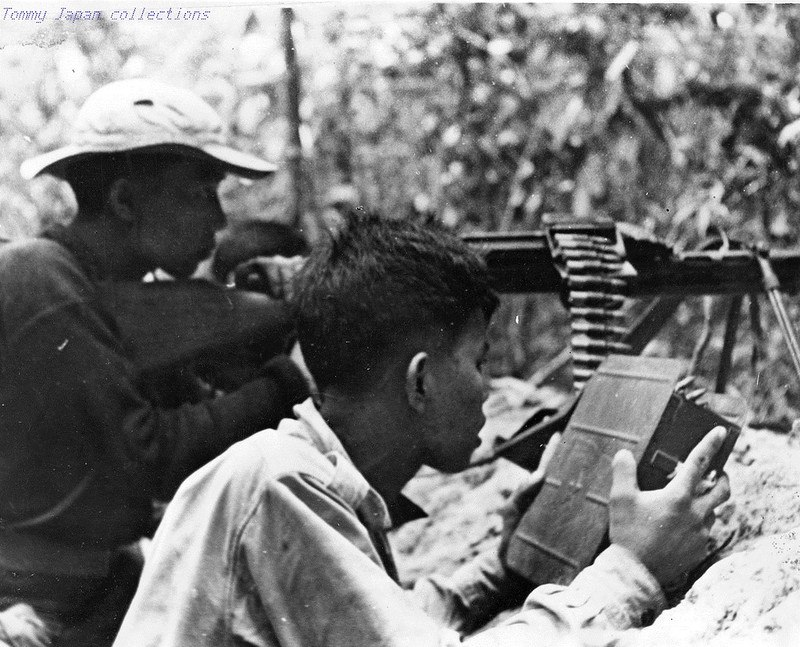
Pryor’s Fight for Survival at Battle of Camp Bunard
Pryor and Phan had gotten to about 30 meters from the outer perimeter when the darkness ahead of them exploded into a wall of fire. Despite AK-47 and heavy machine gun bullets cracking all around them, the duo managed to safely cover the ground to the outside perimeter without being hit. Firing on the run, they moved along the outer defenses until they stumbled on the women and children cowering in small tunnel-like trenches connecting the fighting positions.
Phan yelled at the civilians to run toward the inner perimeter while Pryor provided cover. As the women and children scrambled toward safer ground, Phan fired off a burst in the direction of the Viet Cong. At that moment, an enemy mortar round exploded to their rear, knocking Pryor off his feet. Feeling around with his hand, he found shards of hot, jagged metal sticking out of his thigh. Beside him was his radio, blown apart. Turning to see how Phan had fared, he saw his mangled body, blown into pieces and scattered about.
Struggling to get up, Pryor limped forward in an attempt to stop the Viet Cong before they reached the inner perimeter. After 50 feet, a machine gun opened up on him. He aimed his M-16 at the flames bursting from the darkness, and the machine gun fell silent.
Pryor slapped another magazine into his rifle and moved ahead a few more yards when something hot hit him in the chest, knocking him to the ground like he had been struck by a speeding bowling ball. Swiping away the blood now oozing from a chest wound, he was surprised at its wetness and stickiness.
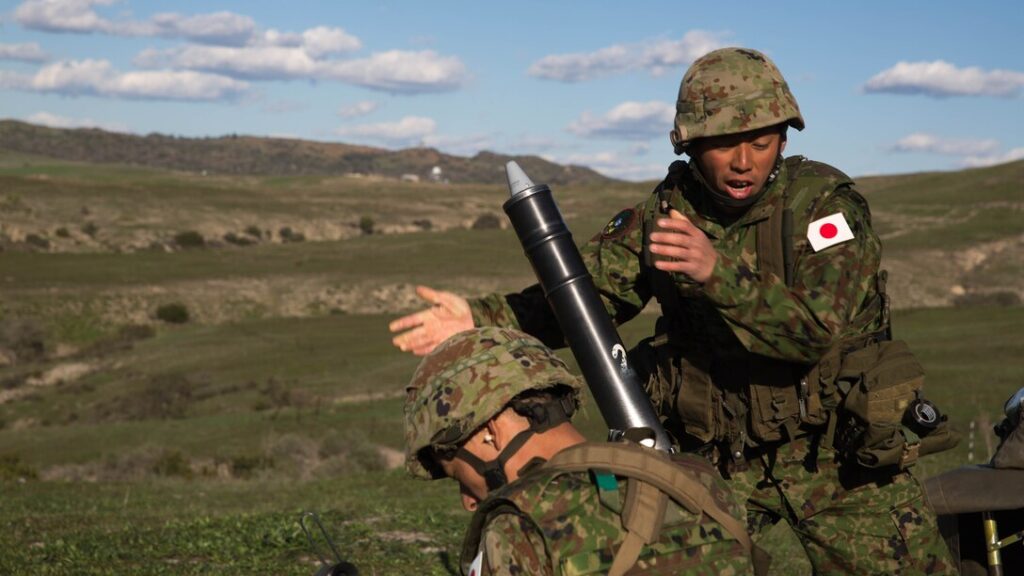
Bullets continued to crack over his head and ripped into the dirt around him. He knew he had to find some cover, fast. Recalling a shallow trench nearby, he crawled to it safely in spite of the fire now concentrated in his direction. But the moment he got into the trench, a grenade blast sent metal fragments into his arms and legs and shattered his rifle. Despair swept over Pryor-a badly wounded man with no rifle, no radio, and dozens of VC intent on killing him.
Crouching as low as he could in the trench, Pryor watched green tracers from enemy bullets pierce the darkness and could feel a number pierce his body. Multiple rounds raked his lower abdomen. His knees, thighs, and left calf were hit. It was a B-40 rocket that tore off the muscle in his forearm and blew off part of his skull.
Lying in the dirt, now completely helpless, Pryor could sense the presence of someone nearby and expected to be finished off with a bullet in the head at any second. But instead, he heard the reassuring voice of one of the camp’s Cambodian medics.
At that instant, the enemy fire grew to a crescendo, and Pryor felt a heavy tug at his throat. A bullet penetrated the base of his neck. Now he could barely breathe and realized that the medic was no longer patching up his wounds. Raising his head, he saw the dying medic at his side, blood spurting from a bullet hole in his head.
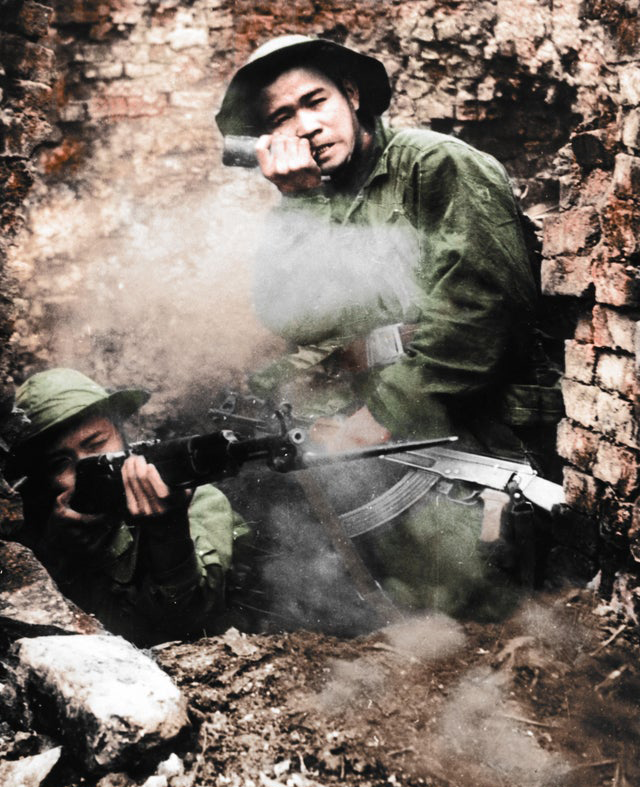
Trying to gauge the extent of his own wounds, Pryor searched the body parts he could reach. He felt blood oozing out of his legs, chest, arms, and stomach. He reached up to his head. Blood and brain tissue met his touch. Shivering from the pain, he grew nauseous from the pungent odor of his own blood.
Amid the clamor raging about him and the searing pain inside him, Pryor could still distinguish the M-16s firing from the inner perimeter and see friendly tracers. Overhead he saw an exploded illumination round drifting to earth. “Thank God, I’m not alone,” he thought. “But what does it matter, really? I’m a dead man.”
As he began to lose consciousness, he also began to hear English-speaking voices. Were they real? He struggled mightily to fend off the fog closing in on his mind as the voices grew stronger, closer. It was Hinson’s voice calling his name. Somehow Pryor got out a muffled, “Over here!”
Medevac Under Fire at Battle of Camp Bunard
In spite of the deafening gunfire and explosions, Hinson heard Pryor’s cry and raced to him, immediately giving him morphine while assuring him he was going to be all right. But Pryor knew nothing could have been further from the truth as he felt himself growing cold. The gash in his chest, neck, and the four head wounds were bleeding profusely. Suddenly, the world in front of him went white. “So,” he thought, “this is how it ends?”
Although also wounded, Hinson somehow carried and dragged Pryor back to the command bunker, with bullets, satchel charges, and mortar rounds chasing him every step. Twice he dropped Pryor because of the slipperiness from his many bleeding wounds.
Finally, Hinson pulled Pryor into the bunker, and Parda helped lay him in a corner and cut off what was left of his clothes to find the wounds and attempt to stem the bleeding. Hinson raced back out of the TOC to continue the fight to secure the outer perimeter.
The battle had been raging for 30 minutes when a pair of gunships arrived, dropping powerful illumination over the camp and exposing scores of Viet Cong desperately trying to hide. The gunships opened up with all the firepower they had. Some VC fell instantly dead, others were wounded. The survivors ran to take refuge in the abandoned 1st Infantry Division camp, from where they continued to fire on Camp Bunard. The gunships shifted to the Viet Cong’s new position and let go with rockets and mini-gun fire and were joined by more gunships.
Meanwhile, inside the operations bunker, Pryor was in a deep coma, his condition worsening with each labored breath. Parda had little success in stopping the bleeding. He cursed the absence of the team’s two medics from the camp. Thank God, Parda thought, a medevac helicopter was inbound, but would it be soon enough?

Parda yelled at Cramer for an update on the dust-off. “About five minutes out,” responded Cramer. Parda prayed the medevac would get there sooner. He feared Pryor would be dead in minutes, maybe even seconds.
With the sound of a dust-off approaching, Cramer radioed the pilot that the situation had become desperate: Pryor was fading fast. The pilot did not respond with the same urgency, telling Cramer he would not risk losing his crew and helicopter by landing in the camp while it was still under enemy fire. Parda grabbed the radio and begged him to please land: “There is only sporadic enemy fire, and my man is nearly dead!”
Seconds later, another medevac came on station. The pilot had heard the exchange between Cramer and the other medevac. He said he and his crew would attempt a rescue and asked for ground guidance on where to land. Cramer told him it needed to be inside the perimeter, as the camp’s helipad was in direct sight of enemy fire. “The only suitable place to land is a very tight fit between buildings with antennas and guide wires in every direction,” Cramer warned. The pilot calmly requested an azimuth on which to vector in.
Hinson, who had returned to the TOC, threw a PRC-25 radio over his shoulder, grabbed a flashlight and a compass, and moved to the area selected for the improvised helipad. Casting a filtered red light into the darkness toward the sound of the hovering medevac, Hinson radioed the pilot the proper azimuth, telling him to bring the nose of the helicopter in on his flashlight.
Slowly and carefully the pilot guided the aircraft down, even as several enemy bullets slammed holes in the chopper’s fuselage. Hinson warned the pilot that he was dangerously close to a building. The pilot adjusted, only to be told by Hinson that he was now too close to an opposite building and a 30-foot antenna.
After several more adjustments called out by Hinson, the pilot squeezed between the structures. The chopper settled gently to the ground, its nose six inches from where Hinson was standing, with three feet between the rotor blades and the surrounding obstacles.
Parda and Cramer rushed the stretcher holding Pryor’s motionless body to the medevac and lifted him up to the crew chief and medic, who pulled him up and onto the cargo floor. While no one would say it, each man’s face showed it: Pryor would not survive.
The pilot lifted off with the same care to clear the obstacles he had taken when landing, pulled power, and headed directly southwest to the 24th Evacuation Hospital at Long Binh. In the cargo bay, Pryor did not stir when the medic on board jammed a transfusion needle into his arm and tried to stop the bleeding.
It took 45 minutes to reach the hospital, where a medical crew was already waiting. The crew chief and medic lifted Pryor’s blood-soaked stretcher and lowered it into the waiting arms of two medics.
Loosely secured to a gurney, Pryor was raced into the emergency room. The pilot and the crew watched, and only when the gurney disappeared into the hospital did they lift off into the darkness.
Recovery and Miraculous Survival at Battle of Camp Bunard
Clinging to life, the 20-year-old was met by several scrubbed doctors and nurses who leapt into action with oxygen, IVs, blood transfusions, and anything else to keep Pryor breathing. It was a very tall task considering the 30 serious wounds and nearly 200 other wounds they counted on his body.
Pryor’s bladder was ruptured; his clavicle and upper rib cage were fractured by the bullet that ripped into his neck; the bullet that tore into his chest barely missed his heart; bullets and fragments of shrapnel were found everywhere, in his torso, legs, arms, and head. Most serious were two head wounds that had blown away 20 percent of the right side of his brain.

The valiant struggle to save the young soldier’s life went on for 23 hours. Like his comrades at Camp Bunard and the fearless medevac crew, no one at the 24th Evacuation Hospital was willing to give up on him.
Miraculously, Pryor did not die on the operating table. However, it took several more operations and procedures in the week ahead to keep him alive. The last procedure, a secondary closure of his head wounds, was done on June 26. A total of seven gallons of blood had been pumped into his veins, and through it all, he never emerged from his deep coma.
On Pryor’s 30th day in the hospital, July 20, 1969, he gradually regained consciousness. He could not see because of his brain injuries, but he could hear. As he came to, he could hear excited voices all around him while a newsman was announcing on television that the Apollo 11 spacecraft had just landed on the moon. With Pryor struggling to listen, Neil Armstrong proclaimed to the world watching in awe: “Houston, Tranquility Base here. The Eagle has landed.”
The first words Pryor heard after 30 days in a coma were among the most historic in all of human history.
Awards and Recognition for Battle of Camp Bunard
For his extraordinary courage that night in battle, Robert Pryor was awarded the Distinguished Service Cross, the nation’s second-highest award for valor. Charles Hinson and Carl Cramer received Silver Stars. John Parda was presented a Bronze Star Medal with “V” device for valor.
Life After the Battle of Camp Bunard
Pryor spent nearly four months recuperating at the 24th Evacuation Hospital at Long Binh, the 249th General Hospital at Camp Drake in Japan, and Travis Air Force Base in California. He then went to the Presidio of San Francisco’s Letterman Army Hospital for rehabilitation and some further procedures. On October 13, 1969, he was sent home on terminal leave with 100 percent disability.

And, Robert Pryor also quit smoking. His last cigarette was the one he lit up just moments before the perfect storm swept across Camp Bunard.
Lt. Col. Michael Christy served two tours in Vietnam, first on a Special Forces A-Team and later with Project Delta’s 81st Airborne/Ranger Battalion. On his second tour, he was the company commander of C Company, 12th Battalion 1st Cavalry Division. A film and television documentary writer, director, and producer, his work appears on the History Channel, A&E, and other networks.
Read About Other Battlefield Chronicles
If you enjoyed learning about the Battle of Camp Bunard, we invite you to read about other battlefield chronicles on our blog. You will also find military book reviews, veterans’ service reflections, famous military units and more on the TogetherWeServed.com blog. If you are a veteran, find your military buddies, view historic boot camp photos, build a printable military service plaque, and more on TogetherWeServed.com today.

A sad tale of a brave man suffering life changing injuries in a war that was fought – not to win….
I cherish my time in Việt Nam to the extent that I’ve been back four times since the war. The people are great and I love it there. I saw very little action during my tour of duty, and when considering my experiences in Việt Nam as a whole, the pleasure was worth all the pain.
Robert… This is Don. You knew me as Don744 on history channel forums several years ago. I would love to catch up with you… Please hit me up at [email protected].
great read
what a remarkable story. he recovered enough to go to college, get some jobs be a farmer and a councilman . I think he should have gotten a Medal of Honor. for all that.
Wonderfully interesting reading. Glad I wasn’t in that part of Vietnam.
What a story Pryor did an exceptional job and survived the ordeal .And the others who helped him . The hospital staff really did a fantastic job .
Steve W Gatchet A nam vet .
Sounds like the normal clusterfuck of communication, coordination, staffing shortages, etc working against guys trying to do their best. Pryor’s buddies did their job, the medicvac crew should get medalled, and the nurses & doctors – yes!
Was at Bunard as radio teletype operator for a few months. I left in Aril of 69 … glad I missed the party.
Thanks for the story and God bless America.
Welcome home brothers
My brother david, served as radio teletype operator in bunard in 1970 in 53rd sig battalion with LTC Moore.
I echo Carl Neal.
Dan Guerrero, USMC Nam Vet.
UPDATE: Through Together We Served and a reprint of this article on another website, I discovered the name of the Air Traffic Controller (FAC) that night. CAPT Richard Gerry was flying overhead and directing the air assets during this battle. We have become TWS Battle Buddies, and he has even sent me a copy of his diary notes from this event. They read in part, “This morning I was awakened to find out that Bunard was being overrun. I took off at 0250 and put in 3 Spookys, a Shadow, 3 Light Fire teams, and 1 set of fighters before daylight. Friendlies took many casualties. One US was seriously wounded. Charlie did not take the camp. How anyone survived that attack is a true miracle!” Any time this article does not agree with Dick’s diary entry, you have to go with what Dick wrote. The entry was made on 20 June 1969, within a few hours of the battle. This information was not available when the above article was written. Becoming close friends, Dick and I are in regular contact, but not to the point that we drive one another crazy. We only write or call one another a few times per week. I’t been three days since I’ve spoken to Charles Hinson, but we also try to remain in constant contact. He’s now 93 years old but hanging tough. You already know from reading the article that Charles is as tough as they come. John Parda and Carl Cramer have stood the final formation.
As a Navy Nurse stationed at Oakland Naval Hospital in Oakland ca. there were many of these amazing young men on our 20 bed amputee ward. It was the greatest experience of my nursing life. They were amazing , brave young Men. I hope some of them are still around & have their sty in the Library of Congress.